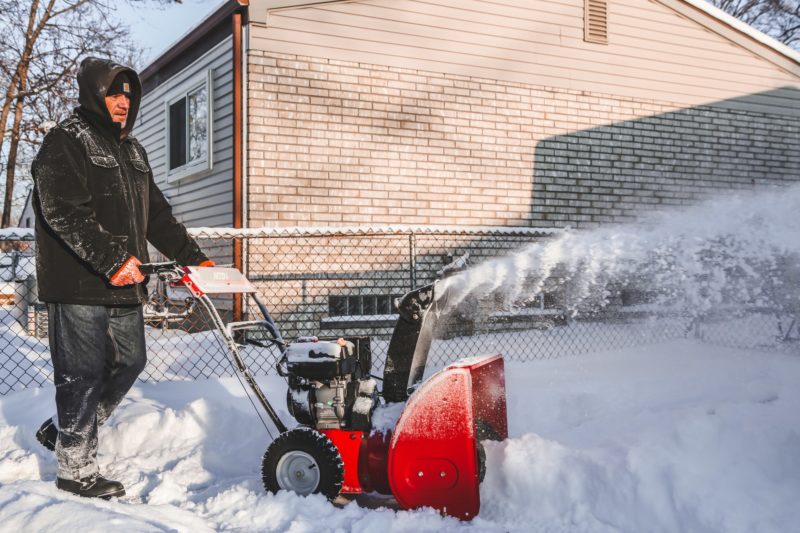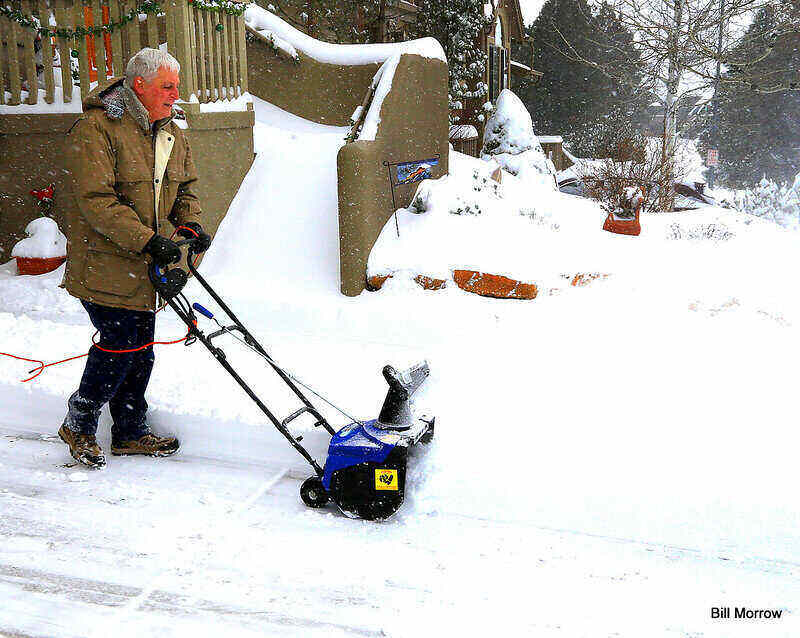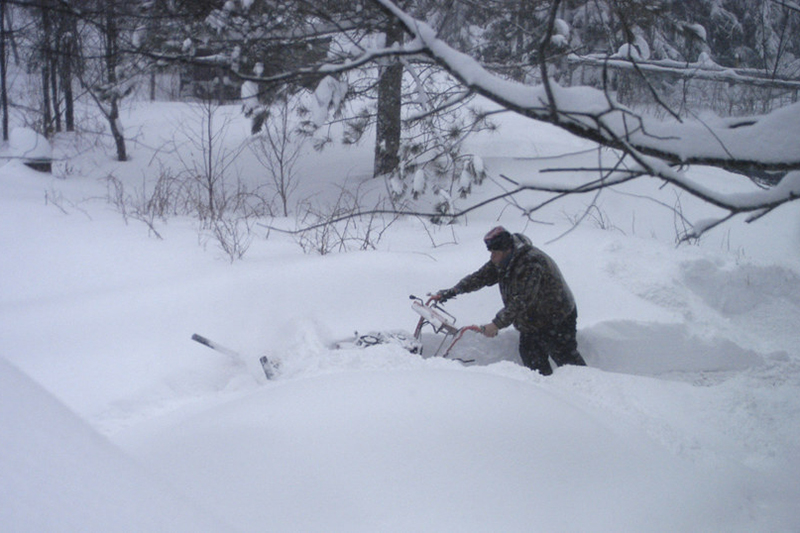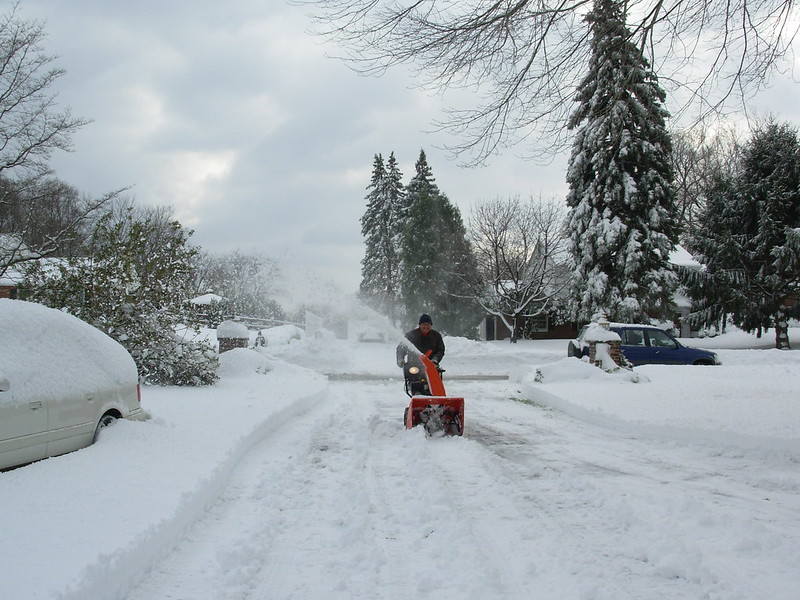The average snowblower costs $1,055, with most models costing between $305 and $1,800. However, cheap corded electric models cost as little as $120, and the priciest commercial snowblowers cost $15,000 or more.
Snowblower prices depend on power source, number of stages, and other cost factors. Small corded snow throwers are the most affordable, costing an average of $190. Gas-powered snowblowers have the highest average price ($1,265) but give you the most bang for your buck.
Average Cost of a Snowblower in 2025
| Average snowblower price | $1,055 |
| Typical price range | $305 – $1,800 |
| Cheap corded model | $120 |
| Expensive commercial model | $15,000 |
We researched snowblowers from the most popular retailers, including Home Depot, Lowes, Walmart, and Tractor Supply. Single-stage corded snowblowers are the cheapest, and commercial three-stage snowblowers are the most expensive.
Cost by Stages

| Number of Stages | Typical Price Range |
| Single-stage | $280 – $770 |
| Two-stage | $785 – $2,015 |
| Three-stage | $1,800 – $3,640 |
What are stages? Snowblower stages are the number of steps a blower takes to clear snow. Although more expensive, higher-stage models are faster and better at handling heavier snow.
Explore snowblower prices by their number of stages:
Cost of Single-Stage Snowblowers
| Average price | $525 |
| Typical price range | $280 – $770 |
| Cheap corded model | $120 |
| Expensive gas model | $1,430 |
Single-stage snowblowers are the most affordable. Most models cost $280 to $770, but cheap corded snowblowers start at just $120.
Single-stage models handle light to medium-duty snow removal:
- What’s the single stage? In one motion the auger scoops up snow and throws it out the discharge chute, so they’re often called snow throwers.
- Clearing depth: Most can clear as much as 6 to 12 inches of snow.
- Clearing width: Most have an 18- to 22-inch clearing width. However, electric snowblowers may have a clearing width as narrow as 13 inches and some single-stage gas models have a 24-inch clearing width.
Cost of Two-Stage Snowblowers
| Average price | $1,400 |
| Typical price range | $785 – $2,015 |
| Cheap 24-inch gas model | $400 |
| Expensive 32-inch gas model | $4,000 |
Most two-stage snowblowers cost between $785 and $2,015. The cheapest two-stage models are small gas blowers and the most expensive are heavy-duty gas blowers with extra-wide clearance.
Two-stage snowblowers handle more snow than single-stage models, quickly clearing medium to heavy snow:
- What are the stages? First, the auger scoops snow and passes it to the impeller. Then, the impeller blows snow out the discharge chute.
- Clearing depth: Most 2-stage blowers clear as much as 12 to 21 inches of snow, but fancy commercial models dig even deeper.
- Clearing width: Most have a 24- to 30-inch clearing width.
Cost of Three-Stage Snowblowers
| Average price | $2,720 |
| Typical price range | $1,800 – $3,640 |
| Cheap 28-inch model | $1.700 |
| Expensive commercial model | $15,000 |
Most three-stage snowblowers cost $1,800 to $3,640, but high-end commercial machines can cost $15,000 or more.
Three-stage snowblowers are lightning fast and fierce, but overkill for most homeowners:
- What are the stages? First, the auger scoops up snow. Next, the accelerator breaks up and pushes the snow. Lastly, the impeller blows snow out the discharge chute.
- Clearing depth: Most residential 3-stage blowers clear about 18 inches of snow.
- Clearing width: Most have a 26- to 30-inch clearing width.
Cost by Power Source
| Power Source | Typical Price Range |
| Gas | $450 – $2,100 |
| Battery | $280 – $1,400 |
| Corded electric | $145 – $235 |
Gas-powered snowblowers have the highest average price and are the most powerful Conversely, corded snowblowers are the cheapest and least capable. Low-potency battery blowers are affordable, but high-performance models are expensive.
Explore snowblower prices by power source:
Cost of Gas-Powered Snowblowers

| Average price | $1,265 |
| Typical price range | $450 – $2,100 |
| Cheap single-stage with manual-drive | $320 |
| High-end 3-stage commercial | $15,000 |
Although pricey, gas-power provides the best bang for your buck. Gas snowblowers have the highest average cost because their lineup includes the most potent models. It’s the only power source with 3-stage models, and most commercial snowblowers run on gas.
Single-Stage Gas Snowblower Prices
| Average price | $660 |
| Typical price range | $445 – $880 |
| Cheap manual-drive model | $320 |
| Expensive heavy-duty model | $1,430 |
Two-Stage Gas Snowblower Prices
| Average price | $1,405 |
| Typical price range | $810 – $2,000 |
| Cheap 24-inch model | $400 |
| Expensive 32-inch model | $4,000 |
Three-Stage Gas Snowblower Prices
| Average price | $2,720 |
| Typical price range | $1,800 – $3,640 |
| Cheap 28-inch model | $1,700 |
| Expensive commercial model | $15,000 |
Cost of Battery-Powered Snowblowers
| Average price | $835 |
| Typical price range | $280 – $1,400 |
| Cheap single-stage model | $200 |
| Expensive two-stage model | $2,200 |
Battery-powered snowblowers are cordless and low maintenance, making them the most convenient. But they give you the least bang for your buck. Small single-stage models are more affordable than the cheapest gas blowers but more expensive than the corded equivalent.
Single-Stage Battery Snowblowers Prices
| Average price | $580 |
| Typical price range | $325 – $835 |
| Cheap 13-inch model | $200 |
| Expensive 24-inch model | $1,200 |
Two-Stage Battery Snowblowers Prices
| Average price | $1,440 |
| Typical price range | $915 – $1,965 |
| Cheap model | $700 |
| Expensive 28-inch model | $2,200 |
Cost of Corded Electric Snowblowers
| Average corded snowblower price | $190 |
| Typical price range | $145 – $235 |
| Small, light-duty model | $120 |
| Expensive self-propelled model | $280 |
Corded snowblowers are low-maintenance, affordable, and only sold in single-stage models. Regarding capability, they give you more for your money than single-stage battery blowers, but that savings comes with a cumbersome cord.
Other Factors Affecting Cost

The following factors also affect snowblower prices:
Cost by Clearing Width
| Clearing Width | Typical Price Range |
| 13 – 15 in. | $130 – $240 |
| 18 – 20 in. | $155 – $435 |
| 21 – 23 in. | $335 – $880 |
| 24 – 26 in. | $750- $1,740 |
| 28+ in. | $1,320 – $2,925 |
Snowblowers with wider clearance are quicker at removing snow but also more expensive. Time is money. So, homeowners with large driveways, parking lots, and patios may find it worthwhile to pay a premium for a broader blower.
Mini models: Very small single-stage snow throwers are often called electric snow shovels. Our favorite electric snow shovel is the ENHULK 12-inch Cordless Snow Shovel.
Cost by Brand
| Brand | Typical Cost |
| Ariens | $530 – $4,100 |
| Craftsman | $520 – $2,300 |
| Cub Cadet | $1,000 – $3,700 |
| Earthwise | $120 – $585 |
| Ego Power | $450 – $2,000 |
| Greenworks | $235 – $2,100 |
| Honda | $2,600 – $4,000 |
| PowerSmart | $210 – $1,050 |
| Ryobi | $280 – $1,300 |
| Snow Joe | $130 – $700 |
| Toro | $250 – $2,800 |
| Troy-bilt | $520 – $2,300 |
Low cost brands:
- Snow Joe snowblowers have the lowest average cost — just $260. They carry many corded models and some cordless electric models.
- Earthwise mainly makes small, light-duty corded and cordless electric snowblowers. Their average model costs $295.
High cost brands:
- Honda snowblowers have the highest average price — $3,160. They make high-power, self-propelled gas snowblowers with coveted reliability and performance.
- Ariens focuses on heavy-duty gas-powered snowblowers. Their lineup includes many 2-stage and 3-stage models, as well as high-end commercial equipment. The average Arien snowblower costs about $1,800.
- Cub Cadet mostly makes 2-stage and 3-stage gas-powered snowblowers that can tread on tough turf. Their average model costs about $1,800.
Cost by Drive System
| Push | Average Cost $310 Typical Price Range $130 – $500 |
| Auger-assisted | Average Cost $600 Typical Price Range $200 – $1,300 |
| Self-propelled | Average Cost $1,200 Typical Price Range $600 – $2,300 |
Before buying a snowblower, consider its drive system:
- Push snowblowers are the cheapest, but they require the most elbow grease. These manual models solely rely on the operator’s strength to move forward.
- Auger-assisted snowblowers are also manual, but with the help of the auger they’re much easier to move on level surfaces. Battery-powered auger-assisted snowblowers are typically more expensive than the ones that run on gas.
- Self-propelled snowblowers are the most costly, but the least strenuous to operate. They work like self-propelled lawn mowers and typically run on gas. Self-propelled snowblowers with power steering are easiest to maneuver on hills.
Additional Features

The following features influence the cost of a snowblower:
- Auger material: Steel augers are the most expensive and the best at removing ice.
- Plowing capacity: Snowblowers with greater plowing capacity clear more snow per minute. They often require high-performance engines/motors and heavy-duty parts, leading to a higher cost.
- Tires: The cost of snowblower tires depends on their size and tread. If you have challenging terrain, expect to pay extra for durable, high-traction tires.
- User-friendly controls: High-end snowblowers tend to be user-friendly with features like joy-stick chute control and one-handed operation.
- Comfort features: Heated handgrips, bright headlights, and power steering add to a snowblower’s cost and comfort.
Cost of a Snow Removal Pro
| Average price per visit | $105 |
| Average price per hour | $50 |
| Average price per contract | $700 |
If you’re not sure about purchasing a snowblower and doing the work yourself, you can always hire someone to do it. Professional snow removal typically costs $45 to $160 per visit, $25 to $75 per hour, or $300 to $1,000 per seasonal contract. The cost of snow removal depends on the removal method, amount of snow, and other factors.
FAQ About the Cost of Snowblowers
What is the best time of year to buy a snowblower?
May to June is the best time to buy a snowblower because that’s when the new models are released. Retailers reduce the prices of the older models.
How much is a snowblower battery?
Most cordless electric snow blowers run on lithium-ion batteries, which typically cost $85 to $330. However, low-end batteries are as cheap as $40 and expensive batteries can cost as much as $600.
What’s the best budget-friendly snowblower?
If you’re on a tight budget, corded electric models are the best snowblowers for small areas with less than 1 foot of snow. For big jobs, gas-powered snowblowers are the most cost-efficient.
Why Hire a Snow Removal Pro?
DIY snow removal is a risky business. Each year, approximately 5,000 Americans go to the hospital for snowblower-related injuries. An additional 11,500 are injured shoveling snow. Please don’t throw the dice when it comes to your health. Hiring an insured snow removal pro is the safest way to remove snow.
Note: LawnStarter may get a referral fee for matching you with contractors in your area.
Main Photo Credit: Pixabay